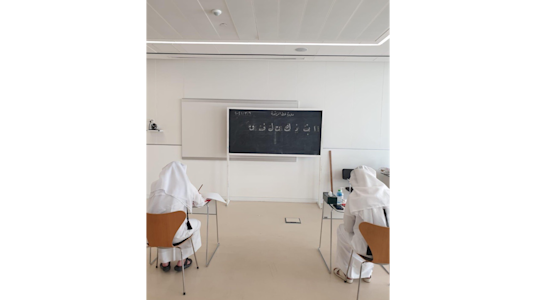Coronavirus (COVID-19) Updates
For the latest COVID-19 information and updates from Qatar Foundation, please visit our Statements page

While the art form represents the visual identity of the language, it can have mental health benefits for non-Arabic speakers, experts say
Reviving the art of Arabic calligraphy has been ongoing at Qatar Foundation, and these efforts are especially remarkable with Doha being chosen the Capital of Culture in the Islamic World 2021.
Arabic calligraphy can be found in buildings and architectural landscapes across Doha, and Minaretein (the Education City Mosque) stands as one of the city’s most stunning works of Arabic calligraphy by Iraqi artist Taha Al Hiti. Minaretein, at Qatar Foundation, is also where workshops on Arabic calligraphy are hosted.

Mr. Mohammad Ibrahim Ghanem, teaching Arabic calligraphy to students at the EC mosque workshop.

Mohammad Ibrahim Ghanem, an Egyptian calligrapher who has been fascinated with this art form since he was a young boy, teaches these workshops. He has taught this art to hundreds of students in his career, and his first and most important advice to those he teaches is to learn the skill of patience. And although these workshops are on hold at the moment, they will return once restrictions are lifted.
A student needs to master the basics first through continuous training, and gradually improving their calligraphy skills.
“I find joy in teaching Arabic calligraphy to others, but – like any other learning process – a student needs to master the basics first through continuous training, and gradually improving their calligraphy skills.
“In our workshops, we currently teach three types of Arabic calligraphy – Naskh, Riqaa, and Diwani. We are looking at the possibility of also teaching Thuluth, Farsi, and Kufi, but at a later stage.”
The workshops, which were put temporarily on hold recently after the further COVID-19 restrictions declared by the Ministry of Public Health, comprise four levels: the first teaches the fundamentals of writing each of the Arabic alphabets separately; the second teaches the rules of connecting the letters; while the third and fourth teach how to write sentences.

Dr. Fatimah Isa, Instructor of Psychology in Medicine at Weill Cornell Medicine – Qatar.
While the workshops attract participants from different age groups, it also includes a diverse mix of backgrounds and nationalities, including non-Arabic speakers. And to explain how art can be perceived by individuals who don’t necessarily understand the Arabic language yet enjoy learning and practicing it, Dr. Fatimah Isa, Instructor of Psychology in Medicine at Weill Cornell Medicine – Qatar, a QF partner university, says that, “most of the time our minds are busy thinking about something, whether consciously or unconsciously – which is a nonstop process – that leads us to experience various emotions which affect our mental and even physical health,” and that human beings can be referred to as thinking machines.
And in this context, many individuals practice different kinds of art for calming the mind. “When we pause our mind, it gives us the time to connect with our inner selves.”
People in the intuition category who are attracted to patterns, symbols, and meanings, may perceive the art of Arabic calligraphy as a way to connect with their inner self.
As a certified analyst of Myers Briggs Type Indicator (MBTI), a very famous personality inventory in the field of psychology, Dr. Isa explains that one of the MBTI dimensions on how people collect information has two dichotomies, which categorize people under sensing and intuition.
People who fall under the sensing category collect data through what they see, hear, or touch; while those under the intuition category are more attracted to symbols, images, patterns, and use their imagination to find their own meanings.

Hamad Al Naemi, Events Planning Coordinator at Minaretein.
“Regardless of people’s culture or language, personality types can influence their interests as well as their behavior,” said Dr. Isa. “And irrespective of our differences, people in the intuition category who are attracted to patterns, symbols, and meanings, may perceive the art of Arabic calligraphy as a way to connect with their inner self, and they may use it for stress management, freeing themselves from the daily demand of dealing with facts and figures.”
Speaking of how the idea of the Arabic calligraphy workshops came about, and how it supports Qatar Foundation’s (QF) mission of inclusivity, Hamad Al Naemi, Events Planning Coordinator at Minaretein, said: “We believe that Arabic calligraphy represents an important aspect of our intellectual and art history. As it embodies the visual identity of the Arabic language, which reflects our culture, identity, and heritage.
With new generations drifting away from this art form, we thought it’s crucial to find solutions that guarantee the preservation of our cultural legacy.
“With new generations drifting away from this art form, we thought it’s crucial to find solutions that guarantee the preservation of our cultural legacy. And this is when we first thought about holding these workshops.” According to Al Naemi, the workshops aim to improve the handwriting of the participants and boost their creativity and artistic perspectives, which also enhances their ability to project their ideas clearly through writing.

